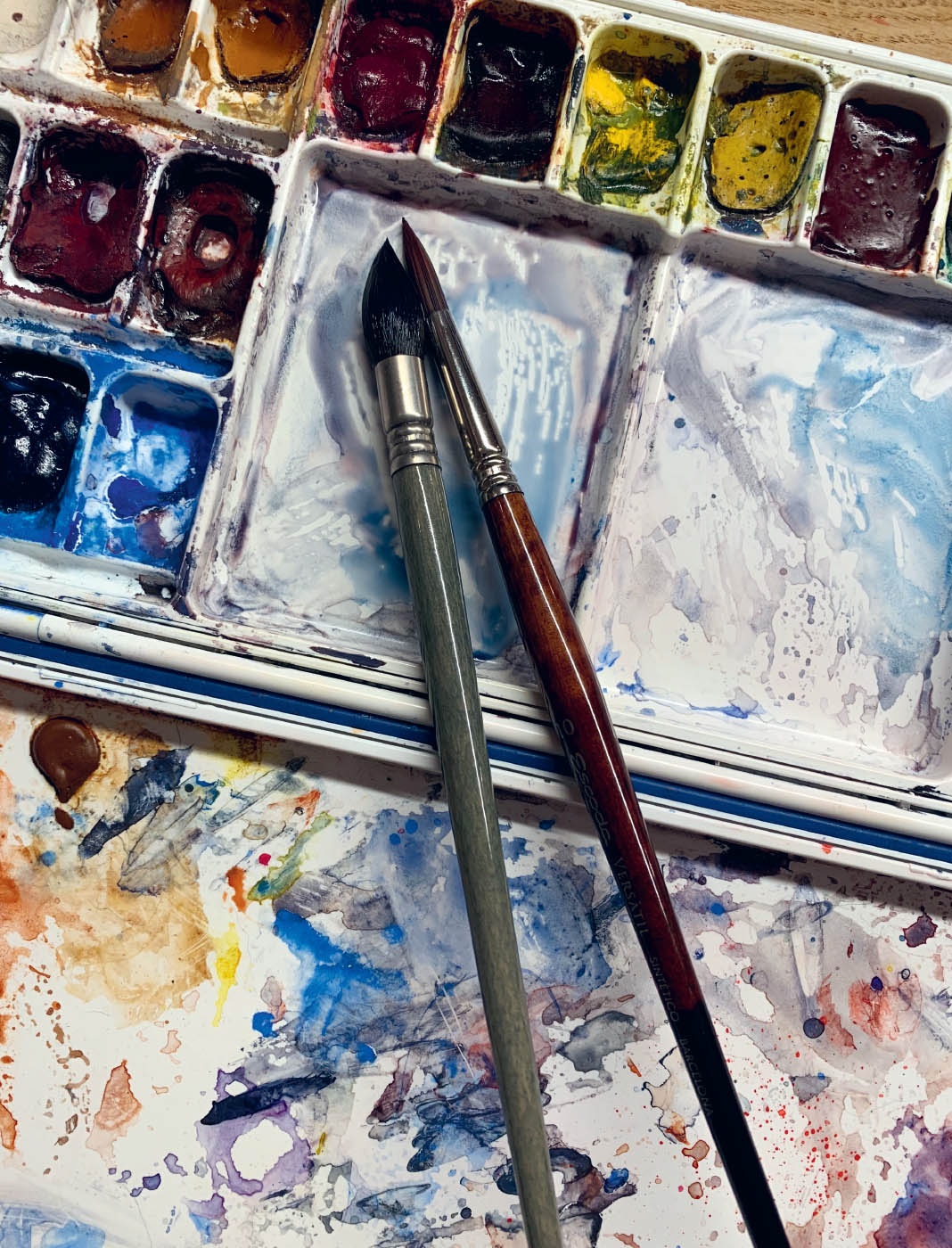
A PERSONAL CHOICE
Tools used to express creativity can be a very personal choice. As you become more comfortable with different tools, you’ll find ones that best express what you want to say. For some, a cheap pen with a steel nib is sufficient. Others prefer something more expensive and stylish. Like most art supplies (and tools in general), you get what you pay for. Remember, the best brush is the one you have with you. The best set of paints is what you have with you. You can do a lot with minimal materials.
Pencils, Pens, and Inks
Making marks on paper is at the root of all sketching. Here are some of my favorite tools that get my sketches off to a good start.
PENCILS
I have a soft touch while sketching so I prefer a darker lead. For me, 4B and 6B pencils are best. Because these leads are soft, I use a mechanical pencil to maintain a fine line without constant sharpening. For highlights, I use a white Conté à Paris sketching pencil. For quickly applying shadows, I like the dark wash (8B) Derwent water-soluble sketching pencil and ArtGraf graphite sticks.

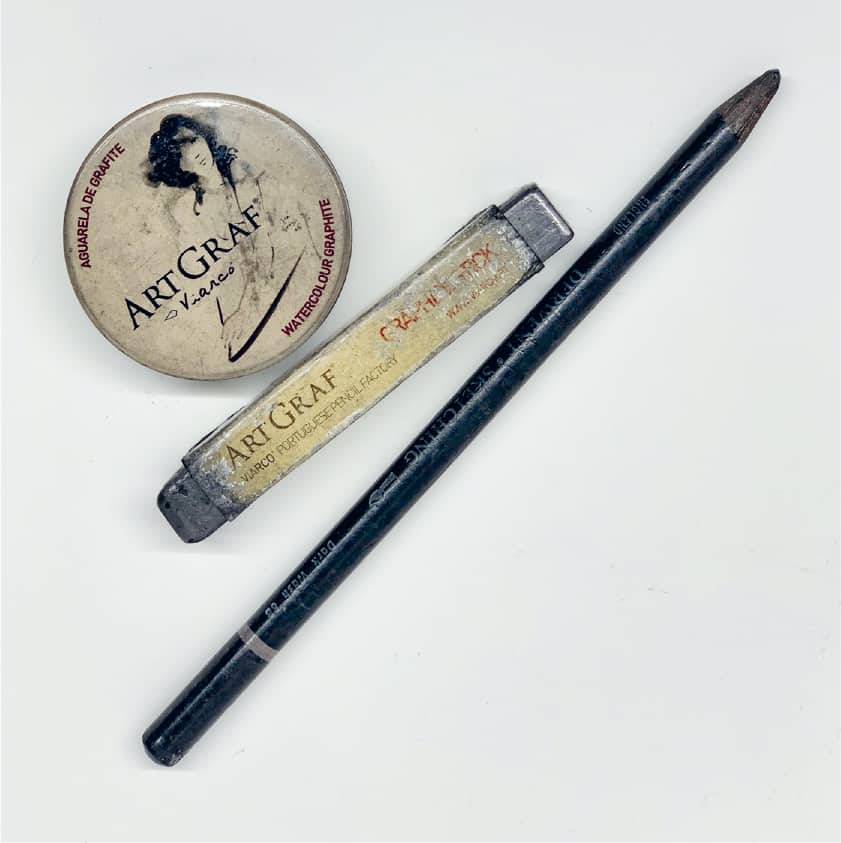
INK PENS
Fine liners, fountain pens, dip pens, and bamboo sketching pens—each tool is unique in its feel and application. I carry many options with me when I paint and sketch, so I always have what I need, depending on my mood and the subject I’m drawing.
FINE LINER PENS
Fine liner pens are felt-tip markers that come in multiple widths, so it’s easy to apply variety to your sketch. They’re a wonderfully simple tool for applying a clean, dark line. I use thicker pens for objects in the foreground, and thinner lines for those in the distance. By varying the line weight in this way, you create a sense of atmospheric perspective while using only black ink. Fine liners typically use waterproof ink, so adding washes of color later won’t smudge your line. Sakura Pigma Micron pens sizes 05, 03, and 01 are my favorite.

DIP AND BAMBOO PENS
Dip pens and bamboo sketching pens give a much more dynamic variety of line. These types of pens have been used for thousands of years, and I can’t help but feel the pull of history when sketching with such traditional tools. I use dip pens in the studio as it’s cumbersome to carry a bottle of ink while sketching outdoors. For me, the risk of one unfortunate spill isn’t worth it.

FOUNTAIN PENS AND INKS
My favorite tool for sketching is a fountain pen. These pens are compact, easy to use, and if used properly, won’t leak. I’ve always been drawn to the appeal of fountain pens, with their elegance and artistry of construction.
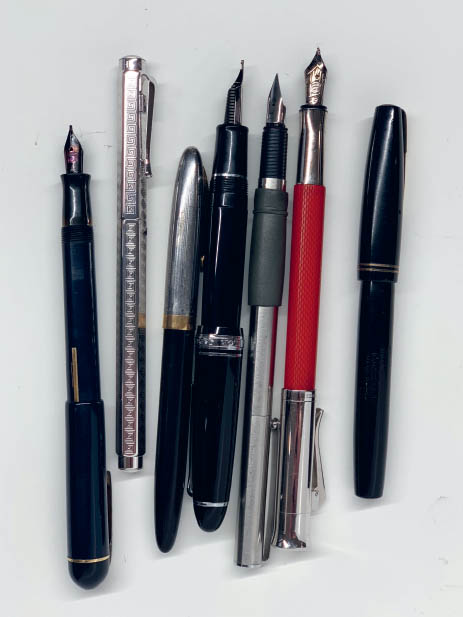
You can choose from an endless variety of fountain pens, so it’s best to experiment and find what suits you. I found my best pens by taking watercolor paper to my favorite pen shop and showing them what I do. I’m not writing calligraphy on wedding invitations, so what I need in a fountain pen differs greatly from most. I’ve tried many pens from different manufacturers, with all kinds of different nibs, drawing on my own paper, in my own style, to see what worked for me and what didn’t. I need ink to flow evenly from the nib, and I love a flexible nib that allows for a variety of line widths. But I also enjoy how my pen skips across rough paper, adding randomness and vitality to my sketches. By trying different pens, you find what fits your hand and style.
I use a Graf von Faber-Castell Guilloche fountain pen with an F (fine) nib. I also have a Sailor 1911 Silver, a Lamy ST with an F (fine) nib, and a few vintage fountain pens from the 1940s: Waterman, Sheaffer, and Eversharp.
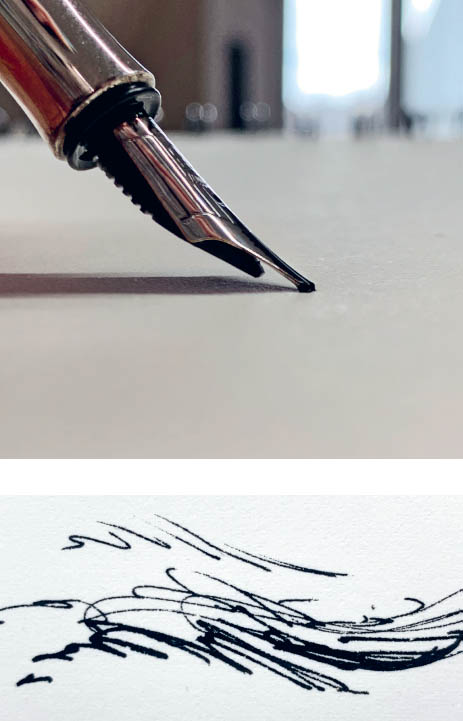
The variety of line widths that can be achieved with a single nib is impressive.

Draw a hairline bead of ink with a light touch. Apply more pressure for a thicker line.
I use refillable cartridges for my fountain pens that I fill with Noodler’s Ink Polar Black ink. This waterproof ink won’t smudge when I wash over it with watercolor. De Atramentis Document Ink is also a very good waterproof ink and comes in a variety of colors.
Water-soluble inks can offer different effects. One I like is Diamine ink in Earl Grey. This is a dark gray ink that, when hit with water, releases purple, red, and aqua tones for some surprising results, like the ones seen in the sketch below of Amsterdam.


Amsterdam. Water-soluble ink on paper.
Paper and Sketchbooks
Paper is perhaps the most important aspect of sketching and watercolor painting. Paper quality has a dramatic effect on the outcome of your work. I recommend 100% cotton paper.
These are some of my favorites:
- ARCHES Aquarelle 300gsm cold press
- L’Aquarelle Canson Héritage 300gsm cold press
- Sennelier watercolor 300gsm cold press
I like using paper in blocks for smaller sketches, so I don’t need to stretch or mount the sheets. If I’m painting a larger piece, loose sheets are best.
Can you ever have too many sketchbooks? Like my paper, I have many books for different moods and settings. A basic sketchbook, suitable for thumbnail sketches and watercolor exercises, is never far from my side.
Here are some of my favorites:
- Strathmore 400 series sketchbook (22 × 28 cm)
- Soft leather covered sketchbook by Moulin de Larroque, France (17 × 22 cm)
- Ruscombe Paper Mill MGX Ivoire 160g (17 × 26 cm)
- Maxgoodz Aquarelle Light (18 × 27 cm)
- Charvin Carnet accordéon d’aquarelle sketchbook
- Clairefontaine naturel A5, 250g paper

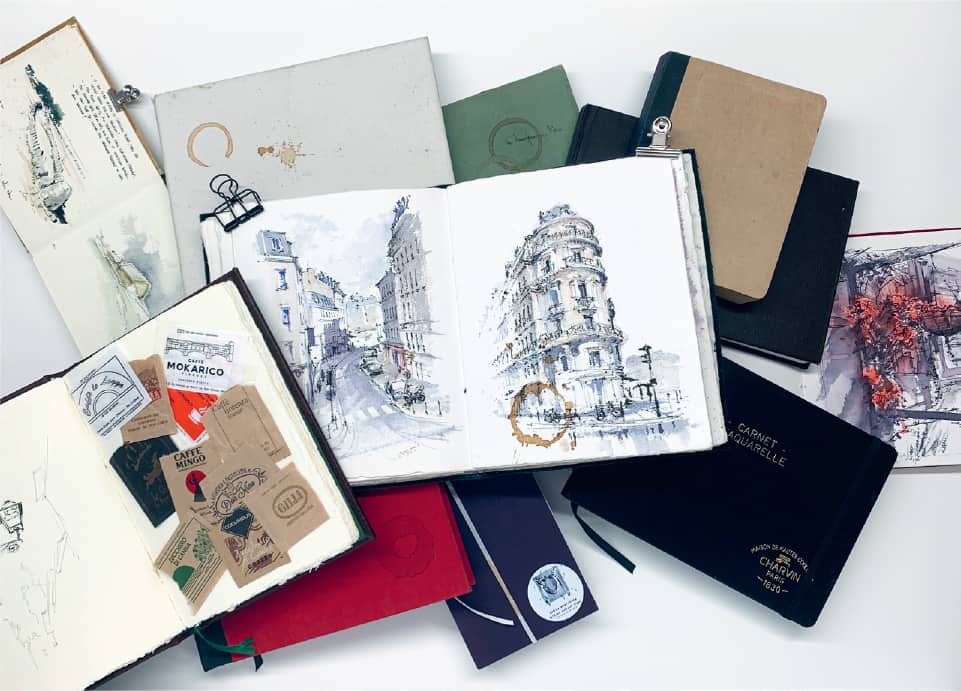
Brushes
I have an addiction to brushes. I can’t leave an art store without some new brush I’m convinced I need. But while sketching, most of my work can be done with three simple brushes: a medium-sized round, a flat, and a mop.
Round brushes, such as an Escoda Perla size 10 or a Van Gogh size 8, provide a nice sharp point for details, while also allowing painting of larger areas.
Flat brushes, such as a Da Vinci Casaneo 30 or Raphaél series 915 size 18, are perfect for large washes of color.
Mop brushes, such as an Escoda Último size 14 or Raphaél series 803 petit gris size 5, are great for initial washes of color.
Another useful brush is a dagger brush, which has bristles cut at an angle to create a knife-like appearance. They can be used to create wonderfully expressive brushstrokes, from incredibly fine hairlines to larger washes. I use my dagger to paint thin tree branches and curly banister railings.
These different types of brushes allow for an immense variety of brush marks. But I always feel it’s better to have a few tools that you know very well than to have a vast array of things you don’t know how to use.
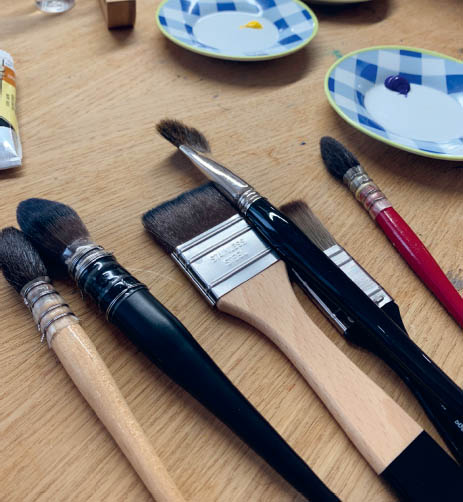
A selection of round, mop, and flat brushes.

Dagger brushes come in a variety of sizes and bristle types.
Watercolor Paint
I primarily use Daniel Smith and Rembrandt paints, but most brands are suitable for what we’ll be doing. I painted for many years with a student-grade set of half pans, so use what you have.
I paint with a fairly limited palette. As with brushes, I’m a real believer in being proficient with fewer materials, rather than having a vast array of things you’re not familiar with. Read more about how to paint with a limited palette in chapter 9 (here).
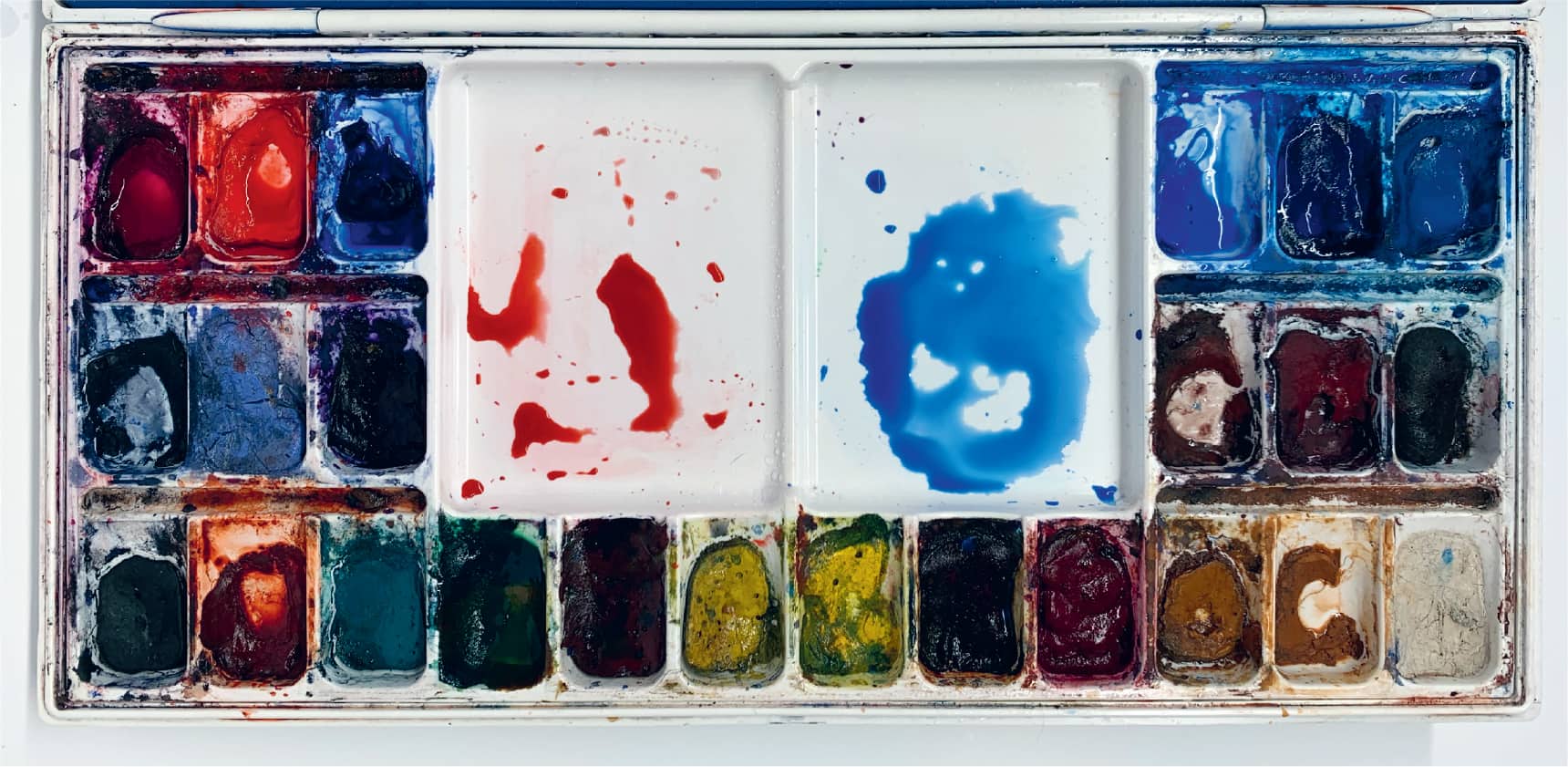
These are the colors I find myself reaching for most often:
- Cobalt blue
- Ultramarine blue
- Burnt sienna
- Raw sienna
- Quinacradone sienna
- Pyrrol scarlet
- Organic vermillion
- Indian red
- Yellow ochre
- Hansa yellow
- Phthalo blue (green shade)
I have a few other specialty colors I keep close, but these are the colors I use the most.

Miscellaneous Tools
I’m always finding new items to add to my sketching kit, and I’m sure you will too. With each sketch, I discover things I wish I had. Here are suggestions for a few additional items to bring with you while sketching.
- Paper towels
- Eraser
- Water container and water


Cairoli Castello, Milan in the rain. Ink and graphite.
Each artist will develop his or her own unique set of tools and additional items to make sketching more enjoyable. When sketching outside, we are limited to what we want to carry with us. Space and weight become a premium. I’m constantly revising what’s in my sketch bag. If I find I haven’t used a brush in a while, maybe next time it will stay at home. But I’m also guilty of bringing too much. I hate the feeling of needing a certain tool and not having it at hand. With practice and many outings, you’ll find your perfect balance.
Of course, the most important tools are your curiosity, your sense of adventure, and your willingness to translate emotion into a sketchbook.
